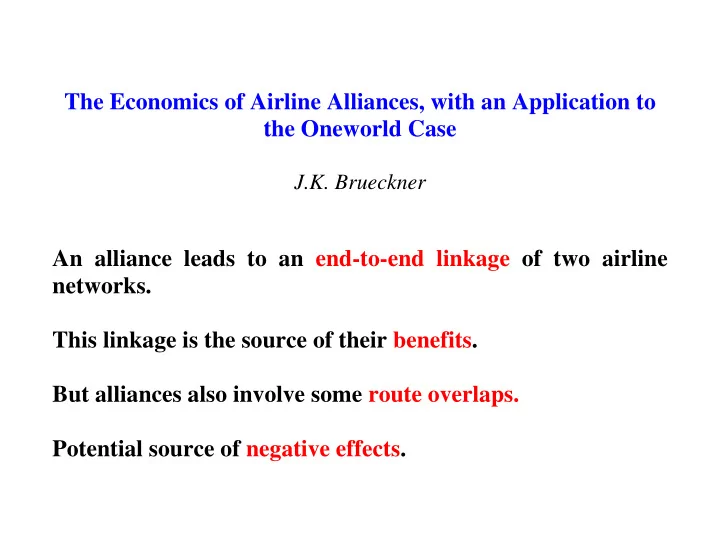

The Economics of Airline Alliances, with an Application to the Oneworld Case J.K. Brueckner An alliance leads to an end-to-end linkage of two airline networks. This linkage is the source of their benefits. But alliances also involve some route overlaps. Potential source of negative effects.
H K Atlantic X Y US airline EU airline End-to-end linkage allows cooperative service in XY market. But overlap in interhub HK market may be anticompetitive.
In absence of antitrust immunity (ATI), fare-setting in XY market involves “double markups.” Acting noncooperatively, each airline sets “subfare” for its portion of the interline trip. Sum of subfares gives overall XY fare. Subfares, in effect, emerge from IATA fare conferences.
Each airline doesn’t consider impact of a higher subfare on other carrier. By raising overall fare, higher own-subfare cuts traffic and reduces other carrier’s profit. In immunized alliance (especially JV type), carriers take into account this negative spillover on their partner.
Subfares are set lower, overall XY fare falls. Key implication: AIRLINE COOPERATION IN XY MARKET IS PRO-COMPETITIVE . Additional benefits include schedule coordination and other convenience-enhancing changes.
Empirical evidence from the 1990’s shows that XY fare discount relative to non-ATI case was as large as 25%. Using these empirical results, aggregate fare benefits from cooperation under ATI have been estimated for many different alliance cases. In latest Oneworld case, Brattle Group estimated annual benefits of $92 million.
The story is potentially different on the HK route. Here, passengers don’t need to combine two airlines to make their trip; it’s an either-or choice. Given the right to cooperate under ATI, alliance partners might try to reduce the number of HK seats sold so as to raise the fare. Could happen even though total HK capacity rises in order to serve more XY passengers.
Limited empirical investigation fails to find evidence of this anticompetitive effect. But it remains a major concern of regulators, especially when HK route has high O & D traffic. In the Oneworld case, HK corresponds to heavily-traveled routes between US gateways and Heathrow airport.
Anticompetitive concern derailed two earlier Oneworld ATI applications. US-EU open skies agreement removed barrier to Heathrow entry and eased this concern enough to allow ATI approval on third try.
Way to address anticompetitive concern is via a carve-out. Prohibits cooperation in fare setting in HK market while allowing it in XY. For an old-fashioned alliance, a carve-out has no downside and is theoretically desirable. But with new JV alliances, carve-out on key interhub route may prevent full integration of operations, blocking some synergies.
If this downside is bigger than upside to carve-out (elimination of potentially anticompetitive behavior), then carve-out is undesirable. USDOT did not impose carve-outs in approving Oneworld ATI, which involves a JV. Logic is consistent with this theoretical argument.
Recommend
More recommend